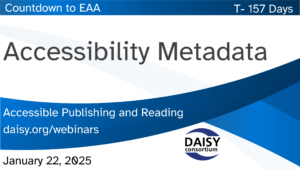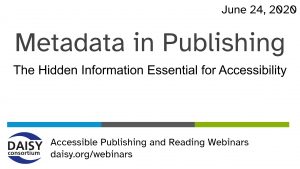Accessibility Metadata, T-157 (W)

In our series of free weekly webinars January 22nd saw a session focused on Accessibility Metadata, a topic that everyone in the publishing industry will agree is essential, particularly as we count down towards the European Accessibility Act (EAA) this year.
This page contains:
Full Video of the Webinar
Speakers
- Richard Orme, The DAISY Consortium—host and chair
- George Kerscher, The DAISY Consortium / Benetech
- Gregorio Pellegrino, The LIA Foundation
- Matt Garrish, The DAISY Consortium
- Marian Oosting, Dedicon
- Laura Brady, Accessibility Expert
Session Overview
In his welcome Richard Orme remarked that metadata is a topic that everyday consumers easily overlook, but which provides the framework that enables the publishing industry to function. It is a requirement of the EAA so great care must be taken in this area.
George Kerscher
George outlined the work that has been done on the Accessibility Metadata Display Guide – in the summer the draft of version 2 of this guide was published and a further draft was released in November 2024 following indepth feedback received from the industry. The guidance is aimed at publishers and distributors to ensure that metadata that is displayed to end users accurately reflects the accessibility of digital content.
Key points to note (and display in your metadata) in this guidance include:
- Ways of Reading – allowing for visual adjustments, support for nonvisual reading and prerecorded audio
- Conformance data – what does the publication actually conform to
- Navigational display statements
- Rich content
- Any hazards that may be included
- Accessibility summary
- Legal considerations
- Additional information
This new version is extremely practical and easy to use and will include localizations for approximately 37 languages, examples of implementation and techniques for both ONIX and EPUB schema.org metadata.
George confirmed during the Q & A that feedback is still welcome and that this is a living document which must be kept up to date.
Gregorio Pellegrino
Gregorio reminded is that the EAA states that all digital publications must be discoverable via metadata. He outlined the supply chain for metadata processing that all publishers and distributors should be familiar with and why there are considerable benefits to using metadata standards in order to comply with the upcoming regulations.
Standards are robust and the result of joint work of many supply chain players from around the world.
By using the standards available publishers will be able to make use of the techniques documents that have been prepared to assist them. Gregorio took us through examples of these documents.
Matt Garrish
Matt introduced us all to an exciting piece of development which complements the guidance and technique documents. We were given a preview of a new accessibility metadata viewer tool which will “convert the accessibility metadata in an EPUB package document or ONIX record into display statements in accordance with the W3C Accessibility Metadata Display Guide for Digital Publications 2.0.”
Perspectives
Marian Oosting told us of her accessibility hopes for the future which include:
- Finding out which standards will be used to check for accessibility in the region
- Looking forward to the Dutch government providing some concrete regulations in the near future
Laura Brady anticipates the supply chain being revolutionized by accessibility metadata and hopes that the new guidance will have a significant impact. She hopes that the EAA will enable and drive this forward. Looking forward Laura commented that there is still plenty of room for plain language guidance and that the backlist is going to require significant attention from everyone with regards to metadata.
In Conclusion
To finish Richard asked George what success looks like in a year’s time. George hopes that all distributors and libraries will display accessibility metadata and that educators and course content designers will use metadata to select accessible course content for students.


 In our series of
In our series of